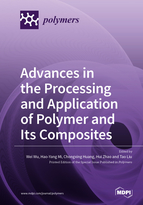Advances in the Processing and Application of Polymer and Its Composites
A special issue of Polymers (ISSN 2073-4360). This special issue belongs to the section "Polymer Applications".
Deadline for manuscript submissions: closed (10 August 2022) | Viewed by 30250
Special Issue Editors
Interests: polymer processing; biodegradable polymer; polymer composites; structure and physical properties of polymers
Special Issues, Collections and Topics in MDPI journals
Interests: polymer processing; polymer foams; multifunctional gels; sensors
Special Issues, Collections and Topics in MDPI journals
Interests: cellulose/polymer composites; packaging; antimicrobial
Interests: polyurethane; cellulose; composites
Special Issues, Collections and Topics in MDPI journals
Special Issue Information
Dear Colleagues,
Polymeric materials and their composites have been widely utilized in hitherto unimagined areas due to their light weight, high flexibility, and excellent processing ability. Along with the fast-increasing consumption of polymeric materials in recent years, the demand for advanced polymer processing technology is ever increasing. Advanced polymer processing, including 3D printing, electrospinning, extrusion, injection molding, compression molding, casting, injection molding, and so on, can convert polymeric materials into various useful products. Obviously, the processing condition, properties, and structures of polymeric materials and their composites have a close relationship with each other. The aim of this Special Issue is to present a collection of research or review papers which can depict the recent progress in the processing and application of polymeric materials and their composites. We would welcome contributions dealing with the related research fields, and I do hope that this stimulating subject will inspire you to submit a manuscript to this Special Issue.
Dr. Wei Wu
Prof. Hao-Yang Mi
Prof. Chong-Xing Huang
Dr. Hui Zhao
Dr. Tao Liu
Guest Editors
Manuscript Submission Information
Manuscripts should be submitted online at www.mdpi.com by registering and logging in to this website. Once you are registered, click here to go to the submission form. Manuscripts can be submitted until the deadline. All submissions that pass pre-check are peer-reviewed. Accepted papers will be published continuously in the journal (as soon as accepted) and will be listed together on the special issue website. Research articles, review articles as well as short communications are invited. For planned papers, a title and short abstract (about 100 words) can be sent to the Editorial Office for announcement on this website.
Submitted manuscripts should not have been published previously, nor be under consideration for publication elsewhere (except conference proceedings papers). All manuscripts are thoroughly refereed through a single-blind peer-review process. A guide for authors and other relevant information for submission of manuscripts is available on the Instructions for Authors page. Polymers is an international peer-reviewed open access semimonthly journal published by MDPI.
Please visit the Instructions for Authors page before submitting a manuscript. The Article Processing Charge (APC) for publication in this open access journal is 2700 CHF (Swiss Francs). Submitted papers should be well formatted and use good English. Authors may use MDPI's English editing service prior to publication or during author revisions.
Keywords
- polymer composites
- biodegradable polymer
- polymer processing
- antibacterial
- thermal stability
- mechanical properties











